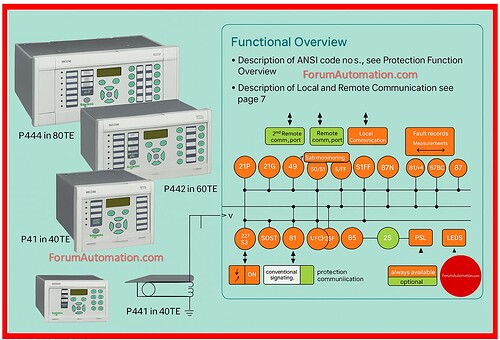Distance protection (21) (IEC Definition)
A non-unit protection whose operation and selectivity depend on local measurement of electrical quantities from which the equivalent distance to the fault is evaluated by comparing with zone settings.
Key Concepts
Non-Unit Protection
Non-unit means that the protection is not dependent on communication with remote ends (or) the entire length of the protected line.
It only takes local measurements (voltage & current at one terminal).
Electrical Quantities Measurements
Typically, voltage (V) & current (I) are measured at the relay site.
From these, the impedance (Z = V/I) is derived.
Because the impedance of a transmission line is directly proportional to distance, this provides an equal electrical distance to the defect.
Distance to Fault
A fault closer to relay has lower impedance, whereas one farther away has higher impedance.
The relay checks the measured impedance against predetermined zone settings to see if the problem is inside its zone.
Zone Settings (Z1, Z2, Z3)
Distance protection is frequently separated into zones for selectivity & backup:
Zone 1: Immediate section, approximately 80-90% of the line.
Zone 2: Includes the rest of the line & a portion of the next.
Zone 3: Backup for remote failures, typically time-delayed.
ANSI Device Number
“21” is the ANSI/IEEE device number for the distance protection in a protective relaying methods.
Working Principle
A fault occurs along the line.
The relay measures V and I and calculates impedance Z as V/I.
Compares Z and zone parameters.
If Z falls within the zone setting, the relay conducts a trip (instant or delayed, depending on the zone).
Advantages
Fast fault clearance (particularly in Zone 1).
Good selectivity.
Can give backup protection.
In comparison to differential protection, no connection with remote relays is required.
Disadvantages
Power fluctuations and load encroachment may have an impact.
High resistance defects cannot be detected properly.
Zone excess and under reach should be carefully coordinated.
Applications
Mainly utilized in transmission lines.
Used in meshed networks & radial feeders.
Frequently used in modern numerical relays with the mho/quadrilateral features.
Reference: IEC 60050-448:1995, Clause 448.14.01
You can also follow us on AutomationForum.co, Facebook and Linkedin to receive daily Instrumentation updates.
You can also follow us on ForumElectrical.com , Facebook and Linkedin to receive daily Electrical updates.
